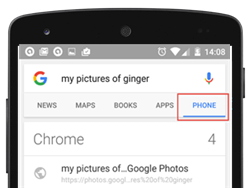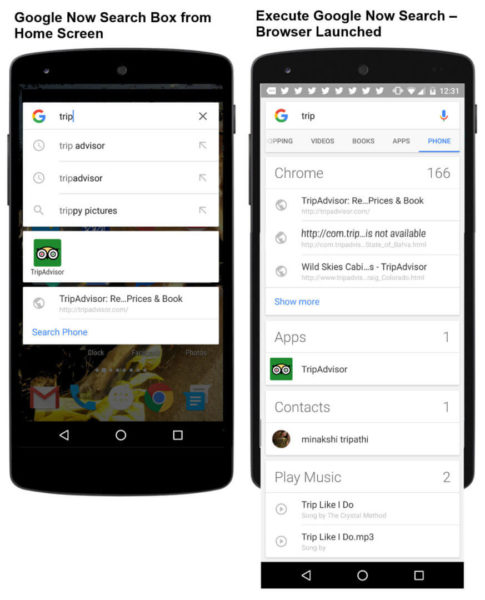Android 6 “Marshmallow” & SEO Series: Google’s Private Index & Screen Crawling
The first of a three-part series on how Android Marshmallow's features and capabilities may impact the future of mobile search. Contributor Cindy Krum explores Google's Private Index and discusses screen crawling.
As over-the-air updates for Android 6, also called Android Marshmallow, start slowly rolling out to some Nexus devices, many SEOs are wondering how this well-publicized update will impact mobile user behavior and search. This is especially true because Google’s enhanced predictive search utility, Now on Tap, will be deeply integrated in the browser and OS.
Having received the update, I can tell you that so far, it has not lived up to the hype; but that does not mean that it will not have a huge impact on the direction and future of mobile search.
To predict the impact of more integrated predictive search, we can start by looking at the mobile Chrome, search and Google Now updates that were made before the soft launch of Android Marshmallow (since they all appeared to be in preparation for the more comprehensive Android Marshmallow launch) and compare them to the post-launch reality.
In the past six months, there have been a large number of subtle and not-so-subtle changes, and this three-part series will review some of those changes and their implications on mobile SEO strategy. While app deep linking and indexing are very important parts of the update, these articles will focus on the more web-based changes.
The three topics covered in this series will be Google’s Private Index, sponsored Google Now cards and the “Click-to-Search” mobile search behavior and results.
Google’s Private Index
Let’s start by delving into Google’s Private Index search results. Google has always collected data from its users for the purpose of personalization (like query, browsing and click history), but now Google also keeps a searchable Private Index.
“Phone” is a new search option/index that Google has made available to all users (with or without Android Marshmallow), as in “Search my phone.” You can find it hidden in the Google Now interface when you scroll to the right in the top navigation.
This is Google’s entry to your Private Index, and it seems to be much like the Apple iOS 9 Private Index, in which information about your private mobile behavior is stored to your phone so that it can be surfaced quickly during subsequent interactions with the OS.
Unlike the iOS 9 Private Index, Google is doing its best to aggregate a user’s behavior across all devices, and their Private Index information is at least partially hosted in the cloud (as opposed to hosting it all locally on your device like with iOS 9).
NOTE: You must begin the search from your Google Now or Now on Tap search function, or from the home screen on your phone. When you execute the search, and the browser launches, you must scroll the navigation to the far right, because the “phone” option will be off the screen. Chrome and Google Now have a slightly different configuration of the search results navigation. If you start a search from the Chrome browser, you currently will not see the same navigation.
What Is In The Private Index?
Items from this index can surface as contacts, emails, apps, previous searches, music and more. On both Android and iOS, you can use Google to search your Private Index for anything hosted in Google’s cloud simply by entering a query like “my flights” or “find all my pictures of dogs.”
Google Now on the Android OS seems to keep users logged in nearly perpetually, but Chrome is different. When you are logged into the same accounts in the Android OS/Google Now and in Google Chrome, the Private Index results seem to be the same. If you are not logged in on Chrome, or if you are logged into a different Google account, Private Index results can be very different, as shown in the comparison below.
All Android users have a default setting that backs up the photos on their phone to their Google Photos account (without posting them live for anyone to see). A user’s private photos, once they are stored in the cloud, are part of that user’s Private Index.
Similarly, Google Music, the default music player on Android phones, will host your music in the cloud and allow it to be stored there and selectively downloaded to your phone or other devices.
NOTE: Google’s contextual understanding and image recognition is still somewhat limited. From the example above, it is clear that Google can understand which pictures are of dogs, but can only pick out my dog Ginger, when the photo is from a Google+ post where here name is present in the image file name/description, as shown. In that same vein, Google is not yet de-duping music collections by comparing audio files and removing duplicates with minor differences in the song or artist name, but it will be great when something like that is added.
There is a variety of other content that is included in the Private Index, and Google appears to be building it out, hosting private content in the cloud whenever possible and accessing it based on which Google account you are signed into on your phone at the time.
If you have content spread over multiple Google accounts, this can still cause massive problems, because you may have to sign out of one account and sign into the other(s) just to search them all for a particular item. If there is local content saved on your phone, and you search for it when you are not logged in, Google won’t be able to find it. Even the photo assistant in the Google Photos app needs to be online in order to search and find photos that are stored locally.
Screen Crawling & Why Now On Tap Is Important For SEO
Private Index content is important because it always out-ranks organic results. Ranking content from the Private Index may be the new ultimate SEO strategy for getting to the top in mobile, but how do you get into a user’s Private Index?
Some of the Private Index information is from the Android OS and stock Android apps like the contacts list, email and Hangouts. Other information is from the user’s logged-in Google behavior on other devices and anything hosted in Google’s cloud.
With Android Marshmallow, other information may be added to your Private Index from deep-linked apps and via Google’s new screen crawler, which seems to mimic an optical character recognition (OCR) technology that can scrape and index the text from web and app screens you access on your phone (currently text only).
Screen crawling can happen at any point when you interact with your Android phone, as shown in the screen shot below.
It has been noted in the Android Marshmallow documentation that this is mostly a way for Now on Tap to understand context and provide relevant information on demand. This is also how Google plans to crawl and index app content that is not submitted in the API and would otherwise be hard to access.
Contextual awareness is the primary benefit of Now on Tap that Google has been pushing, and it is derived from the screen crawling, but it likely won’t be available in the same rich format on non-Android devices. Since Google controls the whole Android OS, Google can access much more information and use the operating system to OCR anything that happens on the phone.
Screen crawling is something that they can’t do on other-OS devices (and apps), so that is a key limitation for Now on Tap and the Private Index when they are accessed on iOS. Google Now won’t be able to index locally stored iOS contacts, photos, on-device behavior or any engagement with iOS deep app links.
How Does Private Indexing Work?
Much like the iOS 9 presentation of Apple Search results, Google’s Private Index results are being populated in the Search Suggest field in Google Now, before the search has actually been submitted. Currently, this includes contacts, music, previous keyword searches, apps that are installed on the phone and previous websites that you have visited.
In the future, it may show emails and other deep in-app content, which is still only available when the full search is executed in a browser window and not available as an instant preview because it is not stored locally, but instead lives in the cloud version on the Private Index. It may also show popular apps and websites that are not on the phone and have never been accessed by the user.
Google still seems to be perfecting this experience, but you can get a sense for their progress with the examples below.
The image on the left shows a search for “trip” that is executed from the home screen, in the Google Now/Now on Tap search box. It includes previous keyword searches, web results and an app result. The image on the right shows the result when the same search is fully executed and a browser window opens. This version shows more historical web pages, an app, contacts and music:
Are There Specific UX Difficulties With The Private Index?
Private results can be turned on and off or even temporarily paused by changing your Google search settings on the web. There is actually a bevy of controls there, including the ability to delete your personal browsing history, export it or move it to a different account.
It should be noted that even when “Private” results are “off,” you may still see personalized results based on your web and app activity — results just won’t include “content” from the Private Index.
Google knows that mobile searchers care a lot about speed, so they are doing everything they can to make mobile experiences fast. With that in mind, we must take into account the value of local caching for Google Now in providing these “Instant” search results from the Private Index.
Since a large portion of the Private Index content is stored locally on the phone, no data or WiFi connection is immediately necessary to fetch the Instant results, and there are no round-trips to a web server to slow down the experience. Cloud-based and web-influenced results are only visible once the search is executed, when a browser window opens. (You can tell what is locally stored by what content can be populated in the Instant results, versus what can only be displayed once a search is executed.)
As previously mentioned, in order to get meaningful results from the Private Index, you must be logged in to your Google Account in Chrome — being logged into a Google account from your phone OS is not enough. As shown below (left image), the Google Now on Tap documentation encourages users to execute searches that query the Private Index from Chrome or Now on Tap. Their suggestions include searching for “my bills,” “my events,” “my pictures” and more.
The example in the middle shows a search for “my past flights,” illustrating that Google indexes not only current but also historical email information that they have captured about travel. (FYI: Flights are indexed based on markup in the confirmation emails, and they have been for a while now. It is interesting to see that they are also archiving a user’s flight history, which certainly would be useful for demographic purposes, with specific application in ad targeting in other channels.)
The example on the right shows a search for “my events” and pulls information from a Google Calendar. Again, if you have multiple Google Calendars, only the events for the calendar that you are currently logged into will show, but events require less markup and Schema to be indexed because the relevant information is already embedded in the calendar invite.
Most of these example searches will work if your primary email is Gmail or if your primary email forwards to your Gmail account, but they still will not work if your primary email is through any other non-Gmail email provider. They will also not work if your email is through Google Apps for Business (which seems like a massive oversight, since this is a service that includes email, calendar and other productivity utilities that companies pay to use).
While Google is not drawing much public attention to its Private Index capabilities, it is clear that it exists and will be highly relevant for predictive search and the future of mobile SEO.
Private Index results always rank at the top of a search result, so savvy SEOs should now start to think about finding ways to get into a user’s Private Index. This will seem a bit new to most SEOs, but it will be well worth it as a strategy for driving top mobile rankings.
This can only be accomplished with deeper, more interactive online engagement, with objectives like encouraging users to download contact files to their address book, sending keyword optimized and marked-up emails, allowing people to add keyword optimized event reminders to their calendars and by publishing apps and app deep links.
As Google Marshmallow and Now on Tap roll out and evolve, it is likely that they will begin to lean heavily on Private Index content, since it will provide the most contextually relevant result available, to help the user find what they are looking for as quickly as possible.
Opinions expressed in this article are those of the guest author and not necessarily Search Engine Land. Staff authors are listed here.
Related stories





